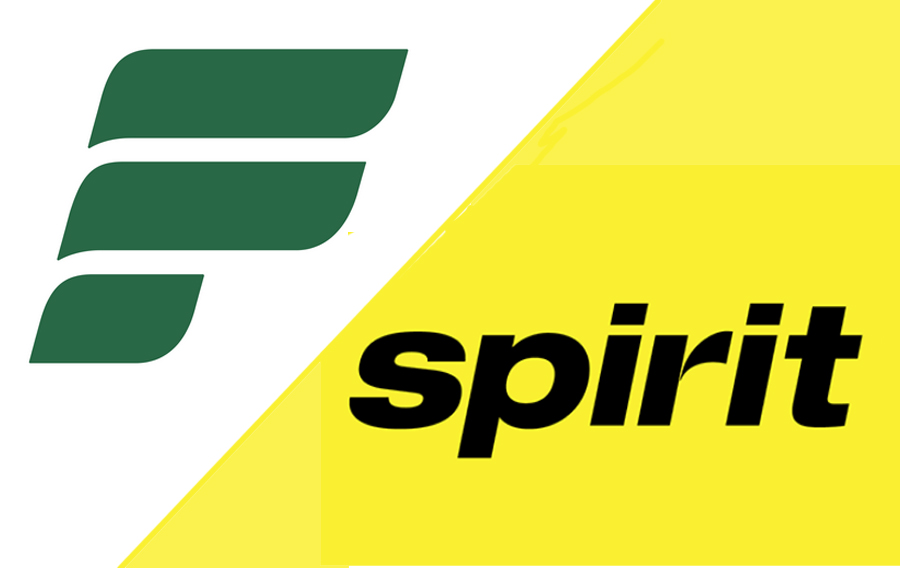Joining Forces

February 8, 2022
THIS WEEK, Frontier airlines announced it would acquire Spirit Airlines, thus turning two of the nation’s biggest low-cost carriers (LCCs) into one.
What does this mean for consumers? Most importantly, fingers crossed, it means we won’t have to look at Spirit’s ugly yellow planes anymore. Beyond that, I really don’t know. Not a lot, probably. Maybe fares will go up in some markets. Maybe they won’t. Any time airlines combine forces, there’s a resulting media chorus about all the awful ways in which the merger will impact travel: higher prices, fewer flight options, and so on. The actual repercussions tend to be subtle.
Frontier’s main hub is in Denver. Spirit’s headquarters are in Florida, with a concentration on eastern cities, as well as numerous routes into Latin America and the Caribbean. In this respect the merger makes sense, with the two company’s route structures complementing one another. A “classic” merger, if you will. Once approved by regulators, the new carrier will be the fifth largest airline in the United States, just behind American, United, Delta, and Southwest.
Frontier was established in 1994, and operates about 110 aircraft. It’s not to be confused with the original Frontier airlines, which collapsed in 1986 after a boondoggled takeover by PeopleExpress. Spirit was founded in 1993, and currently flies 175 planes, all of them of the Airbus A320 series.
Mergers, acquisitions, takeovers. Consolidation is the story of commercial aviation in this country. Take a look at the lineages of American, Delta and United. Those three alone carry the DNA of at least twenty carriers absorbed over the years.
Today we have fewer airlines overall, but there’s plenty of robust competition. Fares remain historically cheap and there are flights going everywhere, all the time. Despite waves of consolidation, the fallout for travelers has been largely positive. The list below highlights the most significant mergers since Deregulation in 1979:
2016. Alaska Airlines purchases Virgin America
2013. American Airlines purchases US Airways
2010. United Airlines merges with Continental
2010. Southwest Airlines buys AirTran (formerly ValuJet)
2008. Delta Air Lines acquires Northwest
2005. America West Airlines purchases US Airways
2001. American Airlines takes over what’s left of TWA
1991. Delta buys the ailing Pan Am’s transatlantic network
1989. USAir takes over Piedmont Airlines
1988. USAir acquires Pacific Southwest Airlines (PSA)
1987. American acquires AirCal (formerly Air California)
1986. United buys Pan Am’s transpacific and Asia network
1986. TWA takes over Ozark Airlines
1985. Delta Air Lines and Western Airlines combine
1986. Northwest merges with Republic Airlines
1980. Pan Am acquires National Airlines
1979. Southern and North Central become Republic
It’s unknown, for the moment, which name the new Frontier-Spirit enterprise will settle on. Will it be Frontier, Spirit, or something completely new? The Frontier name is nice enough, but it evokes a particular region — as it was designed to do. It makes you think of Colorado, the American West. The tails of Frontier’s planes feature a menagerie of great American wildlife: grizzlies, elk, salmon and the like. Spirit is more generic, and probably a better fit for a carrier whose routes reach into South America. Just please do something, anything, about that yellow paint job.
While mergers often appear uneventful on the outside, things can become quite contentious on the inside, among the employees. This especially true within the pilot ranks. Seniority controls everything for pilots, from which plane you fly to the quality of your monthly schedule, and when pilot groups are suddenly combined, the seniority list has to be rebuilt in a way that is more or less equitable to both sides. As the saying goes, good luck with that.
Sometimes, when one airline buys another, the airline doing the buying simply takes the entire roster of the airline being bought and moves it to the bottom. In other words, if airline A purchases airline B, forming airline C, all of the airline B pilots are now junior to all of the airline A pilots. Pilots call this “stapling.” This is what happened when American took over TWA, and is more of a concern when the groups are represented by different unions — or by no union at all.
The Delta-Northwest integration in 2008 was about as seamless and peaceful as the pilots (or their management) could have hoped for. In the cases of American-TWA, or Northwest-Republic, on the other hand, things didn’t go so smoothly. The “green book” pilots from Republic spent two decades clashing with the “red book” pilots of Northwest. To this day many former TWA pilots, some of whom spent years on furlough after their airline was bought by American, feel they were tossed under the bus.
Related Stories:




Leave a Comment
Maximum 1500 characters. Watch your spelling and grammar. Poorly written posts will be deleted!
18 Responses to “Joining Forces”
You are viewing newest comments first. Click to reverse order
Now, instead of two airlines to avoid at all costs, there is only one.
Interesting recap of post-deregulation airline mergers and acquisitions, but I’ll take issue with “2013. American Airlines purchases US Airways”, which essentially has it backwards. US Airways management (Doug Parker and the America West management team) engineered a combination of US Airways and the then-bankrupt American into a new company, under Parker’s management but retaining the American name. This was the second of two “David-eats-Goliath” mergers in which a bankrupt “Goliath’s” name endured but “David’s” management ran the new company.
We’ll see how things go with Frontier Spirit, but airline mergers often feature executives waxing enthusiastic about exciting synergies and many millions of dollars in savings to be realized by the merger, while the actual nitty-gritty of combining two airlines becomes a messy affair into which the promised synergies and savings vanish.
Its a shame skill level is not considered (in a fair) way when rating pilots. I’m any profession, skill levels vary, but just like doctors, pilots hold a special place in society and should be rewarded for excellence.
Like others have said, I hope Frontier’s name survives. If they’re the surviving airline (which it looks like they’ll be), what would they do with Spirit’s A319’s? They already retired theirs, so would they re-integrate them into the fleet (like Delta and their DC-9’s), or sell them off?
Southern, North Central AND Hughes Air West became Republic.
Dad was a CSR for Western at LAX when Delta took them over. There was much friction between the previously unionized Western workforce and the staunchly non-union Delta (or as the WAL folks referred to them, the VD (Veteran Delta).) That friction pretty much lasted until the last previously Western folks aged out of the workforce; Dad retired only a couple of years later.
I bet they stick with the Frontier name. It doesn’t evoke the same thoughts of getting punched in the face while grabbing your bag from the overhead the same way that Spirit does.
What might the new logo look like? Gotta have a logo! Maybe a conspiratorial Q like The Pilot’s latest?
I disagree about Spirit’s yellow livery. Sure, it aint pretty. But it is a) immediately recognizable, b) not EuroWhite, c) unmistakable, and d) did I mention it’s immediately recognizable?
I also disagree with the merger making sense. It makes NO sense for customers/consumers. What they need is fierce competition. They should benefit from innovation and efficiency that arises when carriers have to fight each other tooth and nail in the market with their product. I don’t care if my carrier is big. I do care that they are efficient and offer good value. The best insurance for that is to have many of them and let them duke it out every single day.
The pilot is also wrong about the US having “plenty of robust competition”. That’s of course nonsense and sounds more like airline exec than employee or customer. We DON’T have enough competition. Which is why these days we have just a single trans-con carrier that isn’t engaged in this preposterous race to the bottom (B6). It’s also why almost all carriers charge essentially the same bag fees. Or offer the same lousy service. If we had robust competition in this vast country of frequent fliers, there would be multiple Spirits and multiple JetBlues and lots going on in between. But there isn’t. I hope regulators finally grow a pair and block this merger. Just like they should have before we were left with just three cell carriers.
I don’t think I agree with this. Between any two major cities in the United States, you can basically have your pick of American, United, Delta, JetBlue, Southwest, and now the new Sprontier. That’s six airlines. You can add Alaska, too, in many markets. Yes, particular carriers dominate particular cities, both at hubs and at smaller cities served by their regional partners. But it’s ALWAYS been this way, and it’s rare that a location not offer a choice of at least two or three carriers. I understand your point with respect to more competition resulting in better service and efficiency, but fares are CHEAPER, on average, than they were in the days when we had ten or twelve airlines duking it out, versus the number we have now. Exactly how much competition is enough, by your measure?
Being a Boston guy, go back just a little more and include Delta-Northeast in your list. Long live the Yellowbird, which, unlike Spirit, had just enough yellow in the paint job!
True, the Northeast “Yellowbird” livery was excellent, and way ahead of its time. I thought about including the NE-Delta merger, but decided to use Deregulation as the cutoff point. It was, after all, the early catalyst for much of the consolidation we’ve seen.
Alaska is another airline that has prospered far beyond its origins – but it still serves Alaska (its HQ is Seattle)
OTOH Spirit is one of the worst – 28″ pitch in the cabin and fees for everything. Is it really worth all that agony and aggravation just to maybe save a few $$$?
If it were up to me I’d revive the Braniff name for the 4th time given the route structure of the combined airline. Hopefully after 30 years the name would still have some cache and you could even get away with a mild repaint of the Spirt aircraft if you decided to revive the flying colors livery scheme.
I notice that both airlines’ fleets are all A319/320/321. I assume that will simplify things for the combined company, particularly in terms of parts, service and maintenance, and general logistics. But how does that affect the pilots? Is “stapling” more of a concern when there’s only one type rating required across the whole fleet?
It’s more of a concern when the groups are represented by different unions — or by no union at all. I believe both Spirit and Frontier pilots are part of ALPA, so this is very unlikely to happen.
I agree, the demise of the yellow Spirit livery will be a plus. On the other hand, I’d prefer that the Frontier name remain. For me, it brings to mind the original Frontier Airlines, and it sounds classier, even if it’s not as appropriate for the more far-flung route system of the new company.
Fair enough. Southwest has done just fine with its name, long after expanding beyond the borders of Texas.